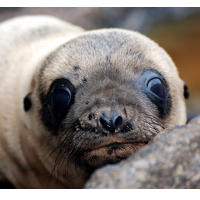Sea Lions Damaged by Algae Toxin “Have No Sense of Which Way to Go”
 (photo: Misuzu Toyama)
(photo: Misuzu Toyama)
Californians have had a long, intense year to observe and catalogue the horrible effects record algal blooms in the Pacific Ocean on sea life, including confused and emaciated sea lions, which have washed up on the shores in increasing numbers.
Now, researchers at the University of California, Santa Cruz can say with precision in the online journal Science how and why these animals are suffering. The Pseudo-nitzschia algae produce a toxin called domoic acid, which was already known to kill brain cells and induce seizures. But now the researchers have determined that the sea lions’ brain damage involves their memory and navigational skills.
“They have no sense of which way to go,” researcher Peter Cook said earlier this week. Around one-third of the 30 sea lions tested suffered from domoic acid poisoning. They were given cognitive behavior tests in mazes and underwent magnetic resonance imaging.
The brain-damaged animals couldn’t remember where their food was and the imaging showed they had a shrunken hippocampus, a region known to affect navigational abilities and memory. Previously, the clinical effects of the toxin were known, but this study showed the behavioral effects in the wild.
Algae blooms are not uncommon. Reuters said the toxin occurs naturally in coastal waters. By “naturally,” they mean a microscopic algae was responsible for the toxin, not some manmade chemical dumped in sea lion breeding grounds, like DDT in the Channel Islands in the 1970s.
But the algal blooms have gotten larger and more frequent in recent years, the latest being the largest and longest ever recorded. It stretched from Alaska to Santa Barbara and lasted for months, not weeks. While the algae is natural, it is nurtured by chemical fertilizers and other products dumped in the ocean as it simmers in warmer waters courtesy of human-induced climate change.
Shellfish and small fish, like sardines and anchovies, eat the algae, and the toxin accumulates in them before they get eaten by sea lions, seabirds and other marine mammals. And then there are those two-legged animals that eat most all of them.
Humans were warned last month against eating Dungeness or Rock crab caught between Santa Barbara and the Oregon border. No one has been reported ill from it, but domoic acid can cause vomiting, diarrhea, abdominal cramps, headache, dizziness, short-term memory loss, seizures and death. Dungeness crab season was delayed.
More than 3,400 sea lions were brought into California rehabilitation facilities during the first six months of the year and a lot didn’t make it that far. That would have been catastrophic if it occurred back in the mid-70s, when the post-DDT sea lion population in the region shrank to 11,000. There are more than an estimated 300,000 today.
“There is something in the environment that has changed, so it is a less healthy place,” Sharon Melin, a wildlife biologist with the U.S. National Marine Fisheries Service, told the San Jose Mercury News. Researcher Cook told Reuters, “The current pattern of much larger and more frequent blooms causing more visible damage to marine animals has been going on since the 1980s.”
There is no reason to think the algae blooms won’t continue to make the ocean a less healthy place to live in the immediate future and now they are bumping up against human appetites. “If we continue to see increasing concentrations in the food web, we're going to need to be more vigilant to protect human health,” Kathi Lefebvre, of the Northwest Fisheries Science Center, told the Mercury News.
–Ken Broder
To Learn More:
Study Documents Sea Lion Brain Damage Due to Algae's Toxin (by Will Dunham, Reuters)
California's Stranded Sea Lions Suffering from Brain Damage Caused by Algal Blooms (by Lisa M. Krieger, San Jose Mercury News)
Sea Lion Survival Skills Impaired by California Algae Bloom (by Kurtis Alexander, San Francisco Chronicle)
Inexplicably Sick Sea Lion Pups Wash Ashore for Third Straight Year (by Ken Broder, AllGov California)
“Unprecedented” Toxic Algal Bloom Closing Fisheries on the West Coast (by Ken Broder, AllGov California)
Sea Lions Exposed to Algal Toxin Show Impaired Spatial Memory (by Tim Stephens, University of California, Santa Cruz)
Algal Toxin Impairs Sea Lion Memory and Hippocampal Connectivity, with Implications for Strandings (Science)
- Top Stories
- Controversies
- Where is the Money Going?
- California and the Nation
- Appointments and Resignations
- Unusual News
- Latest News
- California Forbids U.S. Immigration Agents from Pretending to be Police
- California Lawmakers Urged to Strip “Self-Dealing” Tax Board of Its Duties
- Big Oil’s Grip on California
- Santa Cruz Police See Homeland Security Betrayal in Use of Gang Roundup as Cover for Immigration Raid
- Oil Companies Face Deadline to Stop Polluting California Groundwater





